While most indoor plants release carbon dioxide at night, several species actually continue to produce oxygen after dark, making them ideal bedroom companions. You’ll discover that these unique plants not only purify your air 24/7 but also transform your sleeping space into a serene sanctuary. From architectural specimens that thrive in low light to aromatic varieties that promote better sleep, these seven carefully selected plants will revolutionize your bedroom’s aesthetic and functionality.
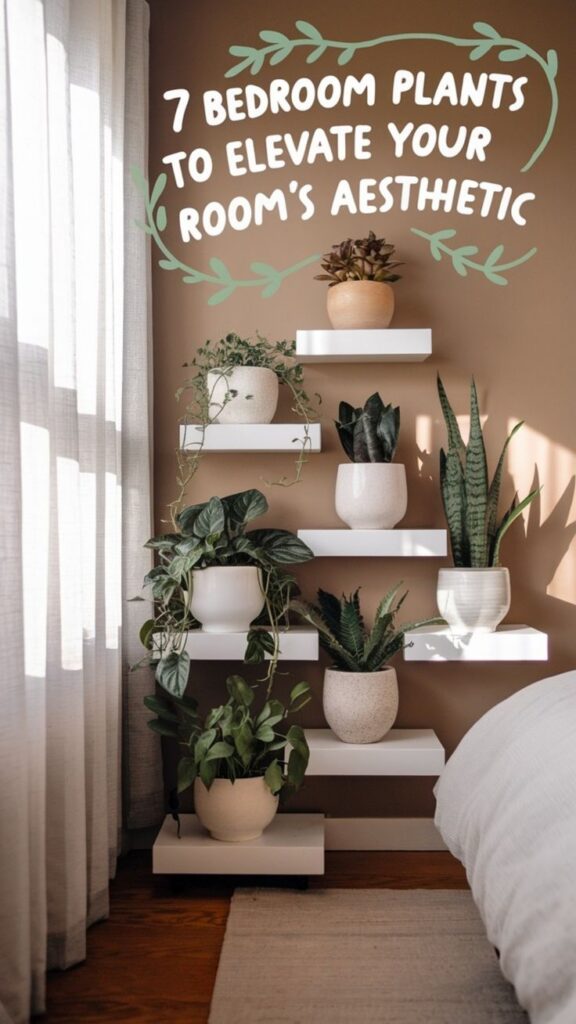
Contents
- 1 Snake Plant: The Ultimate Air-Purifying Bedroom Companion
- 2 Peace Lily: Elegant White Blooms for Better Sleep
- 3 Pothos: Beautiful Trailing Vines for Any Corner
- 4 Spider Plant: A Low-Maintenance Beauty
- 5 Lavender: Nature’s Sleep Aid in a Pot
- 6 ZZ Plant: Thriving in Low-Light Bedrooms
- 7 Aloe Vera: The Multi-Purpose Succulent
Snake Plant: The Ultimate Air-Purifying Bedroom Companion
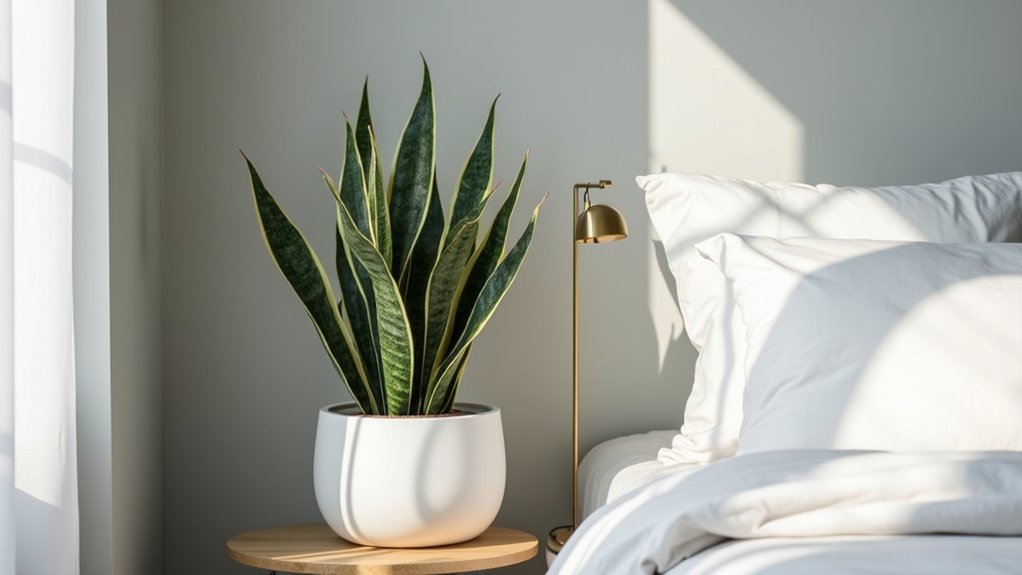
Snake Plants (Sansevieria) are striking architectural plants characterized by their tall, rigid, sword-like leaves that grow vertically, often featuring distinctive patterns of green and yellow variegation.
These hardy succulents are renowned for their exceptional air-purifying abilities, removing toxins like formaldehyde and benzene while releasing oxygen at night, making them ideal bedroom companions. Their modern, structural appearance adds a sophisticated touch to any bedroom decor, and they can grow anywhere from 6 inches to several feet tall depending on the variety.
- Light: Tolerates low light but thrives in indirect bright light; can handle some direct sun
- Water: Allow soil to dry completely between waterings; water less in winter
- Soil: Well-draining potting mix; preferably succulent or cactus soil
- Temperature: Comfortable in normal room temperatures (60-85°F)
- Humidity: Adaptable to most humidity levels
- Container: Pot with drainage holes; slightly root-bound conditions acceptable
Regular maintenance of Snake Plants is remarkably simple but essential for long-term health.
Remove any yellowed or damaged leaves at the base using clean, sharp scissors. Dust the leaves periodically with a damp cloth to maintain their glossy appearance and ensure optimal photosynthesis.
Watch for signs of overwatering, which is the most common issue, manifested as soft, mushy leaves or brown spots. Repot every 2-3 years or when the plant becomes too large for its container, and consider propagating through leaf cuttings or division during this process.
Peace Lily: Elegant White Blooms for Better Sleep
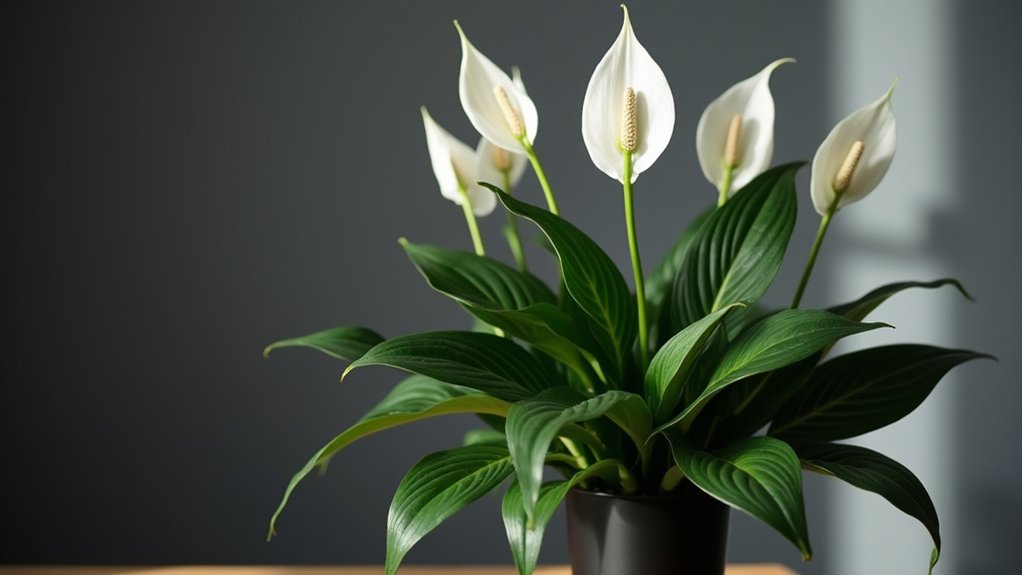
Peace Lily (Spathiphyllum) stands as a sophisticated choice for bedroom decor, featuring glossy dark green leaves and distinctive white hood-like flowers that rise elegantly above the foliage.
This tropical beauty not only adds a touch of class but also serves as a natural air purifier, removing common indoor pollutants while creating a serene atmosphere conducive to better sleep.
- Light: Thrives in medium to low indirect light; avoid direct sunlight
- Water: Keep soil consistently moist but not waterlogged; water when top inch of soil feels dry
- Soil: Well-draining potting mix rich in organic matter
- Temperature: Prefers 65-80°F (18-27°C)
- Humidity: Enjoys high humidity levels of 50% or more
- Fertilizer: Feed with balanced liquid fertilizer every 6-8 weeks during growing season
Regular grooming is essential for maintaining a healthy Peace Lily.
Remove yellowed or browning leaves at the base, and trim spent flowers once they begin to fade.
Dust the leaves monthly with a damp cloth to keep them glossy and maintain optimal photosynthesis.
If leaves develop brown tips, this typically indicates either over-fertilization or tap water sensitivity – switching to filtered water often resolves this issue.
Repot every 2-3 years or when the plant becomes root-bound to ensure continued growth and vitality.
Pothos: Beautiful Trailing Vines for Any Corner

Pothos (Epipremnum aureum) is a versatile trailing vine with heart-shaped leaves that come in various patterns, including marble queen, golden, and neon varieties.
These hardy plants can cascade elegantly from hanging baskets, climb up trellises, or sprawl across shelves, making them perfect for adding a touch of greenery to any bedroom corner. The leaves can range from deep green to variegated patterns of white, yellow, or lime green, growing on vines that can extend several feet in length.
- Light: Tolerates low to bright indirect light; avoid direct sunlight
- Water: Allow top 1-2 inches of soil to dry between waterings
- Soil: Well-draining potting mix
- Humidity: Adaptable to normal household humidity
- Temperature: Thrives in 60-80°F (15-27°C)
- Fertilizer: Monthly feeding during growing season with balanced liquid fertilizer
Regular pruning is essential to maintain the desired shape and promote bushier growth, with trimmed stems easily propagated in water to create new plants.
Dust the leaves periodically with a damp cloth to keep them glossy and photosynthesizing effectively, and remove any yellowed or damaged leaves promptly.
While pothos is generally pest-resistant, inspect occasionally for common houseplant pests like mealybugs and spider mites, especially around the leaf joints and undersides.
Spider Plant: A Low-Maintenance Beauty
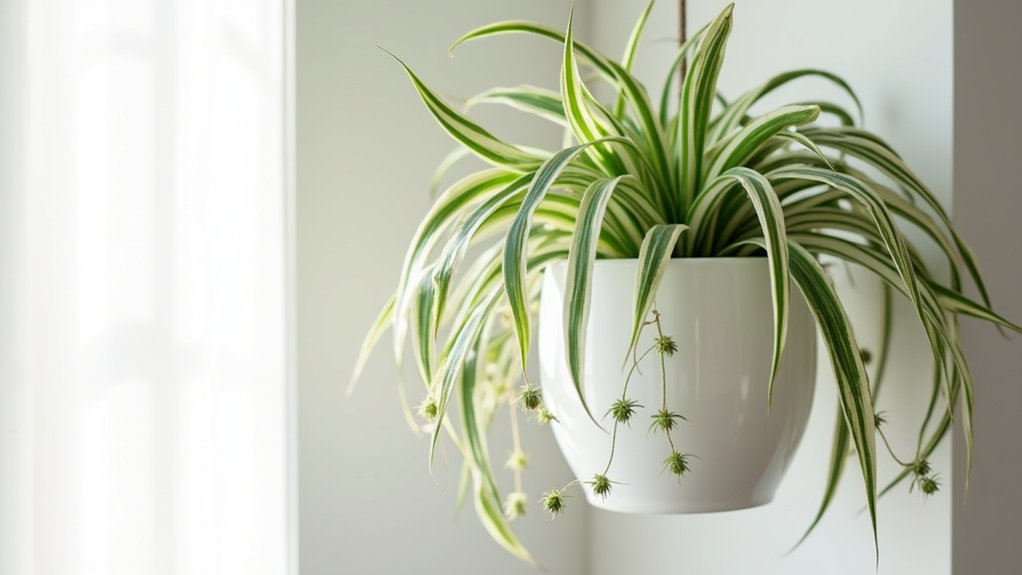
Spider Plants (Chlorophytum comosum) are beloved for their graceful, arching leaves that cascade from the center, creating a fountain-like display. Their distinctive appearance features long, narrow leaves with variegated stripes in green and white, earning them the nickname “airplane plant.”
Most notably, mature spider plants produce long stems called stolons, from which baby plants (plantlets) dangle, resembling small spiders hanging from a web.
- Light: Bright to moderate indirect light; avoid direct sunlight
- Water: Allow top 1-2 inches of soil to dry between waterings
- Soil: Well-draining potting mix
- Humidity: Tolerates average household humidity
- Temperature: 60-75°F (15-24°C)
- Fertilizer: Light feeding every 2-3 months during growing season
Regular grooming keeps spider plants looking their best and encourages healthy growth. Remove any yellowed or brown leaves by cutting them at the base.
The plantlets can either be left to enhance the plant’s appearance or removed to prevent the parent plant from expending extra energy. If the leaf tips turn brown, this usually indicates over-fertilization or sensitivity to fluoride in tap water; switching to filtered water can resolve this issue.
Repot every 2-3 years when the plant becomes root-bound, choosing a container just one size larger than the current pot.
Lavender: Nature’s Sleep Aid in a Pot
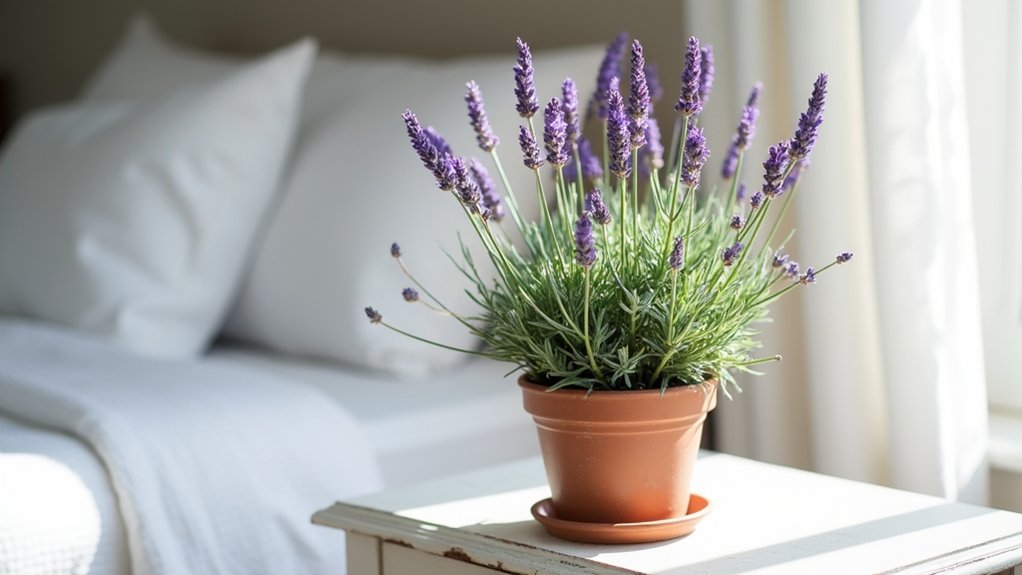
Lavender, with its distinctive silvery-green foliage and delicate purple flower spikes, brings both visual charm and therapeutic benefits to any bedroom space. This aromatic herb releases a soothing fragrance known to promote relaxation and better sleep quality, making it an ideal choice for bedside placement.
The compact, bushy plant typically grows 1-2 feet tall, featuring slender stems crowned with clusters of small, tubular blooms that attract pollinators when placed outdoors.
- Light: Requires 6-8 hours of direct sunlight daily; south-facing windows are ideal
- Water: Moderate watering; allow soil to dry between waterings
- Soil: Well-draining, slightly alkaline soil with added sand or gravel
- Temperature: Prefers 65-70°F (18-21°C)
- Humidity: Tolerates low humidity; avoid misting
- Container: Terra cotta pots with drainage holes
Regular pruning is essential to maintain lavender‘s compact shape and encourage continuous blooming. Trim spent flower stalks back to the leafy portion of the plant, and shape the foliage into a mounded form after flowering.
Remove any yellowed or dead foliage promptly to prevent fungal issues, and avoid fertilizing frequently as lavender thrives in lean soil conditions. During winter months, reduce watering frequency and ensure good air circulation to prevent root rot.
ZZ Plant: Thriving in Low-Light Bedrooms
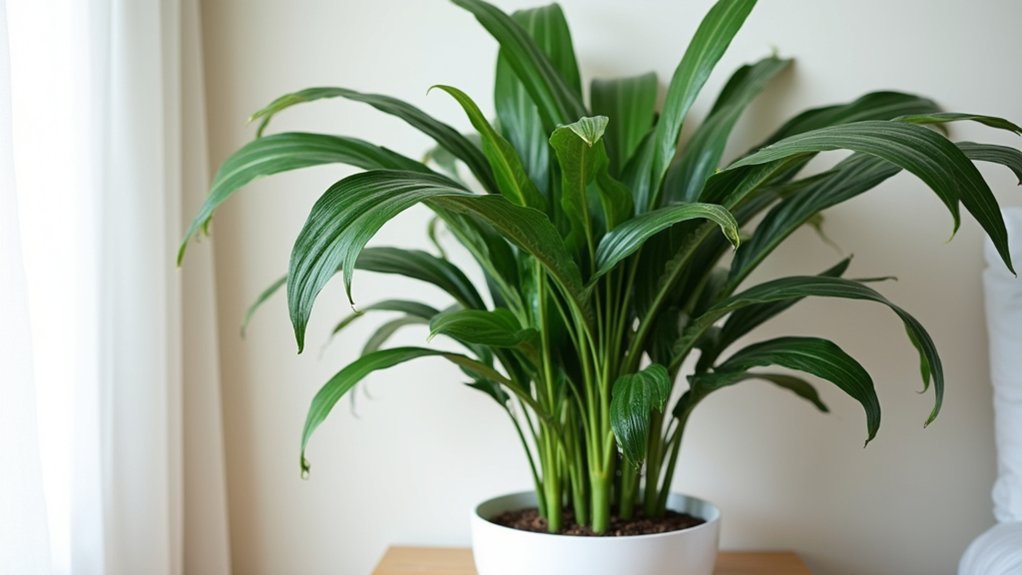
The ZZ Plant (Zamioculcas zamiifolia) is a striking, architectural houseplant known for its glossy, dark green leaves arranged in a feather-like pattern along sturdy stems. This tropical perennial grows in an upright fashion, reaching heights of 2-3 feet, making it an excellent floor plant or statement piece for bedroom corners.
Its thick, waxy leaves not only provide visual interest but also help the plant store water, contributing to its exceptional drought tolerance.
Growing conditions:
- Light: Tolerates very low light to bright indirect light; avoid direct sunlight
- Water: Allow soil to dry completely between waterings; water every 2-3 weeks
- Soil: Well-draining potting mix with good aeration
- Temperature: 65-75°F (18-24°C)
- Humidity: Adapts to average indoor humidity levels
- Container: Pot with drainage holes to prevent root rot
To maintain a healthy ZZ Plant, remove any yellowing or dead leaves by cutting them at the base with clean, sharp scissors.
Dust the leaves monthly with a damp cloth to keep them shiny and maximize their ability to photosynthesize in low light conditions. While the plant is highly resistant to pests, occasional inspection of the stems and leaves helps catch potential issues early.
Fertilize sparingly with a balanced houseplant fertilizer during the growing season (spring and summer), applying at quarter-strength every two months.
Aloe Vera: The Multi-Purpose Succulent
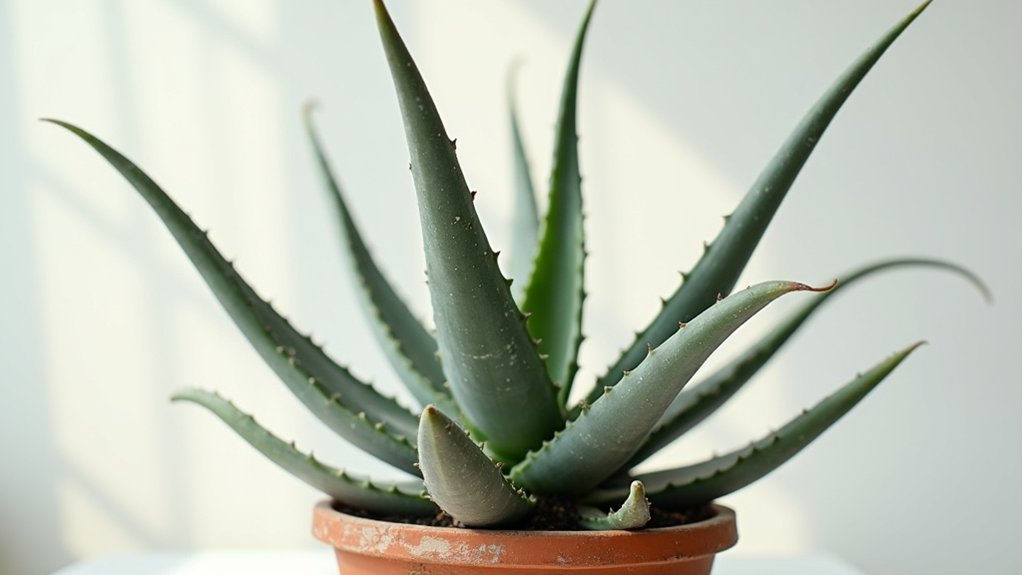
Aloe Vera is a striking succulent characterized by its thick, fleshy leaves that grow in a rosette pattern. The leaves are lance-shaped, featuring serrated edges and a gray-green coloration, sometimes with white speckles. This hardy plant can grow up to 2 feet tall and produces yellow tubular flowers on tall stalks when mature, though indoor plants rarely bloom.
Beyond its ornamental value, Aloe Vera is renowned for its gel-filled leaves, which contain beneficial compounds used for medicinal and skincare purposes.
- Light: Bright, indirect sunlight; can tolerate some direct morning sun
- Water: Allow soil to dry completely between waterings; reduce watering in winter
- Soil: Well-draining cactus or succulent mix
- Temperature: 55-80°F (13-27°C)
- Humidity: Tolerates low humidity levels
- Container: Pot with drainage holes, preferably terracotta or clay
To maintain a healthy Aloe Vera plant, regularly remove any dead, damaged, or yellowing leaves by cutting them close to the base.
Watch for signs of overwatering, such as soft, mushy leaves or brown spots, and adjust watering accordingly. Repot every 2-3 years when the plant becomes rootbound, and remove any offsets (pups) that develop around the base to prevent overcrowding and maintain the parent plant’s health.
During growing season, feed with a balanced, water-soluble fertilizer diluted to half strength every 4-6 weeks.
